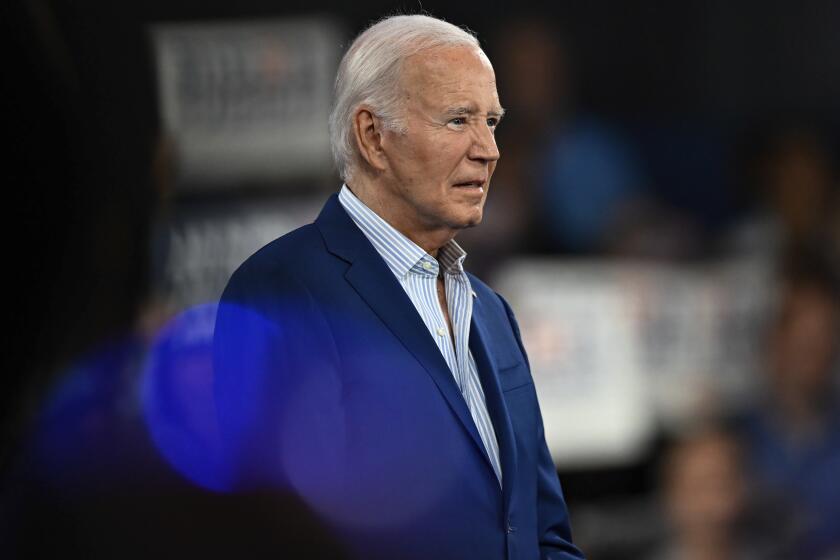BOOK REVIEW / NONFICTION : A Travel Diary That Reads Like Literature : THE LOST HEART OF ASIA <i> by Colin Thubron</i> ; HarperCollins $23, 374 pages
- Share via
The place that Colin Thubron calls “the world’s heart” is what used to be known as Soviet Central Asia and is now a vast puzzle whose pieces are newly minted nations with ancient names: Uzbekistan, Turkmenistan, Kazakhstan, Kyrgyzstan, Tajikistan.
“For mile upon mile the only colour was a terrible, famine- breathing platinum, less like pure sand than the pulverised clay of the empires which had petered out in its dust: Persia, Selucia, Parthia, Macedon,” Thubron writes. “It was awesome and somehow expected: that the heart of the world was not a throbbing organ but a shifting question mark.”
Thubron is one of those unconquerably curious and superbly literate travelers that the English seem to breed in abundance. His earlier adventures in the former Soviet Union, China and the Muslim world are the subject of a series of well-regarded novels and travel memoirs, and now he tells us tales of his experiences as a stranger in yet another strange land in lush prose that often soars into poetry.
Thubron describes exactly what he sees at eye level--the men and women he encounters and the here-and-now of their curious and often desperate lives--but history and politics are never quite out of mind. For example, when he introduces us to a beleaguered Russian woman in newly independent Turkmenistan, she speaks words that could have been uttered by any number of dispossessed European settlers in Africa or Asia over the last century or so:
“Will these people regret it when we go? The Russians run everything here! We’re the only people who make things work. When we’re gone, what will their future be?”
Of course, Thubron is always quick to remind us that the history of these lands is measured not merely in decades or even centuries but millennia. And so he is more likely to invoke Alexander the Great or Genghis Khan or Tamerlane than more recent Russian overlords.
Thubron expects to find an eruption of Islamic fundamentalism in the Muslim communities of Central Asia, but what the Soviets left behind turns out to be an odd hybrid of several orthodoxies. He happens upon Jews at prayer in a synagogue where Hebrew is now a forgotten language, a gentleman in a homburg hat who was among the Germans deported from the Volga by Stalin during World War II, and an unlikely congregation of Baptists who were converted by “a rich Korean . . . from Los Angeles.”
Indeed, Thubron describes a world in the grip of a collective identity crisis. At a mosque in Bukhara, Uzbekistan, for example, he encounters Gypsies sacrificing a sheep, peasant women making obeisance to an ancient tree believed to induce fertility and cure backache, and a few rather befuddled devotees praying at the mausoleum of a Sufi saint.
“He scarcely knew the history of the saint he served,” Thubron writes of one worshiper, “but lapsed into communist jargon, describing him as a Stakhanovite holy man who achieved through work and planted melons.”
As Thubron shows us, the countries of Central Asia--and the people who live there--have been cruelly severed from their own memories and traditions. In Stalin’s days, a mosque in Uzbekistan was turned into a Museum of Atheism; today, the Lenin Museum in Kyrgyzstan has been made over as a museum where the battle maces of Tartar warriors are on display. And so no one quite knows the authentic history or destiny of what Thubron calls “the hinterland of God’s vengeance.”
“The city’s heart seemed numb with lessons and memorials,” he writes of the Russified city of Tashkent. “People faded to shadows here.”
For me, the emblematic scene in “The Lost Heart of Asia” is a visit to a ruined mausoleum in the desert of Turkmenistan, one of dozens of crypts and mosques and castles that seem to litter the dreamy landscape across which Thubron wanders.
“You watch out in those ruins,” says the driver who escorted Thubron into the desert. “They’re haunted.”
“By whom?”
“I don’t know,” the driver answers. “People have been heard crying there.”
So it is with Thubron’s book. He invites us to places that are haunted by history, and the anguished voices we hear in these pages might belong to the ghost of the Veiled Prophet of Khorsan--or a flesh-and-blood woman keening over the burial stones of long-forgotten nomads.
Thubron cannot be sure, and neither can we.
More to Read
Sign up for our Book Club newsletter
Get the latest news, events and more from the Los Angeles Times Book Club, and help us get L.A. reading and talking.
You may occasionally receive promotional content from the Los Angeles Times.







